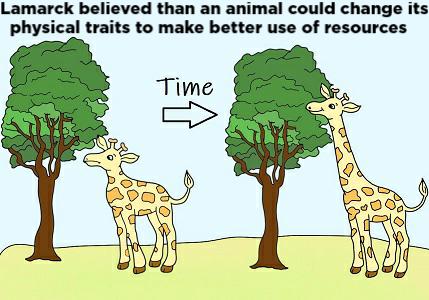
Lamarckism- Introduction and Postulates
- Evolution is a slow, continuous and irreversible process of change. Organic evolution is the process of slow and gradual but regular changes in the life forms from simple to complex.
- The first attempt to describe the process of organic evolution was made by Lamarck in 1809.
- Lamarck is a French biologist. He observed a lot of organisms and postulates a theory.
- According to Lamarck postulation of evolution, the acquired characters achieved by an organism during their life time can be transferred or transmitted to offspring. Even in the offspring, these modifications become pronounced depending upon continuous use or disuse of the organs. After certain generations the offsprings produced become totally different from their original parents giving new species.
- The environment factors force the living organisms to change and adopt themselves accordingly.
- On the basis of transmission of acquired characters whole postulation is known as “theory of inheritance of acquired characters”.
The theory of inheritance of acquired character is simply known as Lamarckism. And this theory consists of following postulates.
Effect of environment:
- The environment changes regularly due to different geological or bio-physical processes. The change in environment greatly affects the habit, habitat and composition of living organisms. This change in environment increases the possibility of new organisms with respect to various habitats.
Effect of use and disuse of organs:
- The use and disuse of any organ affects the development of organ and body too.
- According to change in environment, body tends to increase the size of the organ which are used most frequently and continuously. It means the frequently used organs become more developed and become more strong and large.
- When the organ is not in continuous use, it gradually reduces in size and disappears or remains as less developed form (Vestigial form).
Inheritance of acquired characters:
- All the changes occurred in an organism are preserved with in the body. These acquired characters are then transmitted to their offspring through the gametes.
- This inheritance of acquired characters is due to use and disuse of organs. Therefore, after many generations, new species are formed which are distinctly different form their ancestors.
Evidence to prove or support Lamarckism:
- There are some examples by which theory of evolution can be best explained in favour of Lamarck.
- Long necked giraffe:
- The evolution of long necked giraffe took place from short-necked giraffe due to continuous stretching of the neck muscles in order to find food from tall trees. In the beginning, the short-necked giraffe used to eat the grasses. Later on, sources of grass on land reduced and it forced to eat the leaves of tall trees stretching of neck is continuous and is gradually transmitted to offspring’s.
- Loss of limb of snake:
- The continuous creeping through holes and crevices made snakes body elongated and due to continuous disuse of limbs because they hinder while creeping in burrows results in loss of their limbs.
- In the same way, vestigial organs in human and other animals show disuse of those organs.
- Web of hind limbs of frog:
- Development of webs on hind limbs of frog and ducks for swimming in water because they used more continuously in search of food.
Criticism of Lamarckism:
- The theory of inheritance of acquired character by Lamarck is distinct and simple. However, it lacks scientific evidences. Following are the criticism made upon Lamarckism:
- The evolutionary trend in certain groups of organisms may be associated with increased in size as mentioned by Lamarck but there are many examples of organisms where evolution brought about by reduction in size. For examples; Many ferns and conifers were gigantic trees, but now they are much smaller in size.
- Inheritance of acquired character during life time to offspring is not possible. For example; Black smith and metal workers have strong muscles but such strong muscles is not transmitted to their offsprings.
- Several experiments have proved Lamarckism is
wrong;
- Drosophila was kept in total darkness up to 76 generation but no modification was observed in the offsprings.
- Tailless mouse was not born even when 20 generations of mice were cut tail for an experiment by Weisman
- Eyes that are being used continuously and constantly develop defects instead of being improved.
